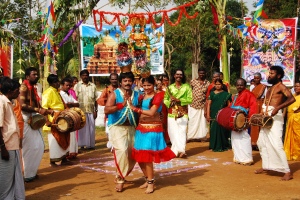This Thiruvizha Never Ends

They are colorful, fun and infectious. Even as Kollywood churns out thiruvizha numbers by the dozen, CT joins the festivities and finds that they’re here to stay…
Boom, boom, boom goes the urumi melam. The nadaswaram and thavil join the party along with the lead singer, who starts on a high pitch with an equally booming voice. That, gentlemen, is the signal for the thiruvizha to begin and the group dancers begin their footwork in tune with the energetic beats. Of late, this scene of a village in the midst of a celebration has become a common sight in our Tamil films.
“Any event in a village — be it a temple festival or a marriage – will be celebrated with pomp and fervour never witnessed in cities. Such festivals not only reflect the culture of the people but are also a way of life in our villages. A filmmaker has to narrate his story in two-and-a-half hours and what better way to get his audience quickly into a film than with such numbers?” asks popular comedian Karunas, who has turned composer with the recently-released Rajathi Raja.
What are the challenges that filmmakers face when going for such numbers? Choreographer Kadhal Kandhas says that there are two kinds of thiruvizha numbers — one shot during the day and the other picturised at night. The latter, he reveals, is easier as one can choreograph with a lesser number of people and the audience will be none the wiser.
“When you shoot the song during the day, you not only have to recreate the festive atmosphere but also ensure that a huge crowd is visible even in a wide shot,” he says.
An authentic portrayal is a must, he feels. “People in a temple festival will never dance in unison. So, to bring in a realistic feel, I ask my troupe members to dance in their own style while maintaining the tempo of the song,” he explains and reveals that he recently used a real festival to shoot such a song in the soon-to-be-released Eesa.
But, haven’t such numbers become a case of one too many in recent times? “Definitely,” says Kandhas and adds, “There were a lot of thiruvizha songs that did not click prior to Paruthiveeran. But once the song in Paruthiveeran became a hit, directors today are requesting their composers to come out with similar numbers.”
While he feels that this is just a trend that will meet its end sometime, director Sasikumar, whose Subramaniapuram had an authentic-looking thiruvizha song, believes that each festival song is different from the other. “Each village has its own culture. So, you’ll find that the song in Paruthiveeran is different from the one in Subramaniapuram which again will be different from the one in Vennila Kabadi Kuzhu. So, there is no way that the people are going to get bored by these songs,” he adds with conviction.
But it is Karunas who puts it best. “Many of the folk arts that I witnessed during my youth are almost extinct today. Film songs like these enable us to archive the remaining few, like the Oyilattam and Mayilattam, for our future generations. They ensure that our folk art continues to live in the years to come.”
Copyright ©2009 Chennai Times
leave a comment